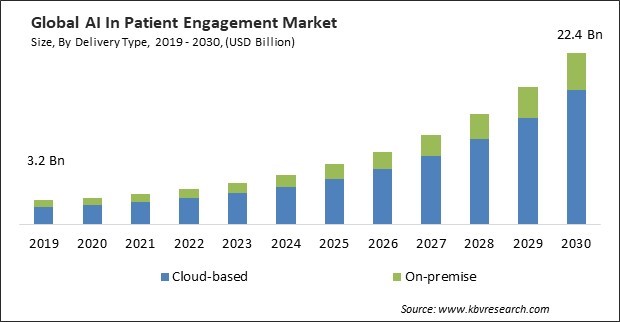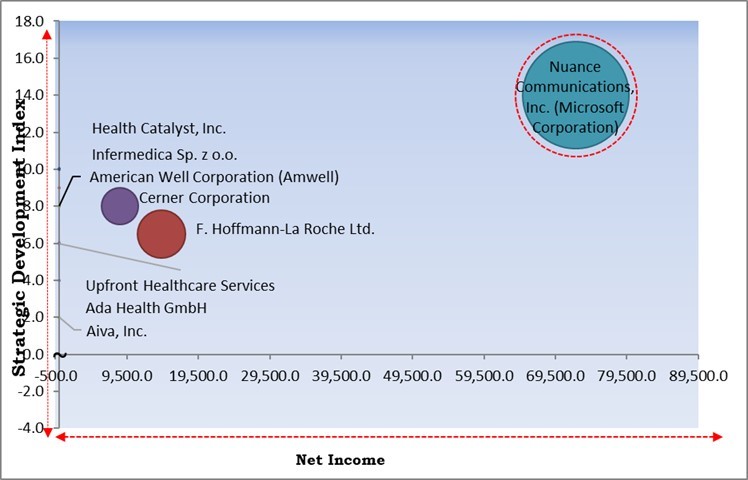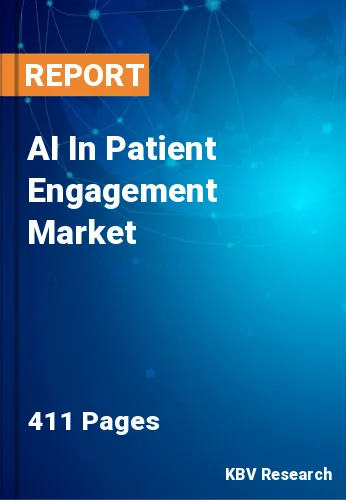The Global AI In Patient Engagement Market size is expected to reach $22.4 billion by 2030, rising at a market growth of 22.3% CAGR during the forecast period.
Secure AI-enabled chatbots integrated into the billing software can use account data and previous interactions to provide individualized patient help when needed. Consequently, the billing and payments segment captured $564.7 Million revenue in the market in 2022. Increasing billing accuracy guarantees that patients are accurately billed for the services received, which lowers the need for customer support and payment delays. Practice management software with AI capabilities can effectively collect and modify details about patients, removing human data entry errors and guaranteeing correct patient information. By recognizing past due amounts, creating customized payment reminders, and providing patients with simple payment options, AI can enhance payment collection tactics. Some of the factors impacting the market are adoption of ai in healthcare sector globally, development of huge and complex healthcare databases and lack of high-quality medical data.

The major strategies followed by the market participants are Partnerships, Collaborations & Agreements as the key developmental strategy to keep pace with the changing demands of end users. For instance, In October, 2023, American Well Corporation partnered with Nestlé Health Science, for digital health programs, launching the Advanced Surgical Nutrition Automated Care Program in the U.S. Additionally, In May, 2023, Roche UK, a subsidiary of F. Hoffmann-La Roche Ltd., partnered with Nye Health, digital health technology company, to co-create adaptive digital solutions, integrating information from smartphones, wearables, and medical records for a comprehensive view of patients' health outside traditional clinical settings.
Based on the Analysis presented in the KBV Cardinal matrix; Nuance Communications, Inc. (Microsoft Corporation) is the forerunners in the Market. In, May, 2021, Nuance Communications extended collaboration with Athenahealth, Inc., to integrate its cloud-based Dragon Medical into the AthenaOne EHR and Mobile App. The integration aimed to provide a seamless, voice-driven experience for AthenaOne Dictation users, reducing documentation time and workload for clinicians and enhancing patient experiences. Companies such as Cerner Corporation, F. Hoffmann-La Roche Ltd. and American Well Corporation (Amwell) are some of the key innovators in the Market.

To maximize their revenue potential, healthcare companies are already making significant investments in AI technologies. They implement technology to carry out various duties, such as chatbots for patient care, planning, imagining, and predictive maintenance. Businesses may expect significant changes and increased efficiency as AI takes on more and more duties in the healthcare industry. The current boom in AI investment and research has resulted in a rapid increase in AI applications. These apps claim to improve not only business results but also the quality of life for people. The fact that so many large corporations and start-ups are embracing AI in patient interaction indicates that this is a significant area for expansion. The use of AI in patient engagement is spreading worldwide, and governments of many nations are supporting it, therefore, it is a growing market.
For instance, large-scale and intricate data, also referred to as big data, in the healthcare sector includes clickstream and web and social media interactions; sensor, electrocardiogram (ECG), X-ray, and pulse oximeter readings; medical device readings; claims for healthcare and other billing records; electronic health records (EMRs), prescriptions, as well as biometric data, among other types of information. Today's enormous amount of data has the potential to support a broad range of healthcare and medical jobs. Advanced analytics, machine learning, and AI techniques are emerging along with many opportunities to turn this data into significant and actionable insights to support clinical decision-making, deliver high-quality patient care, respond to emergencies in real-time, and save more lives. Therefore, using technologies like AI to drive insights from complex databases supports the demand for AI in patient engagement tools.
However, for both clinical and technical verification of AI models, clinicians need access to high-quality datasets. However, gathering patient data and imaging to test machine learning algorithms becomes difficult because medical data is fragmented across multiple EHRs and IT platforms. The main issue is that pertinent data is not easily accessible. For models using machine learning and deep learning to accurately categorize or predict a broad range of tasks, massive datasets are necessary. Industries with simple access to massive datasets have seen the biggest advancements in machine learning's capacity to produce increasingly accurate and sophisticated algorithms. In contrast to multimodal learning, certain contemporary algorithms might be able to function on a unimodal or smaller scale, and the growing use of cloud-based servers might mitigate the inverse issue of storing these always-growing datasets.

The leading players in the market are competing with diverse innovative offerings to remain competitive in the market. The above illustration shows the percentage of revenue shared by some of the leading companies in the market. The leading players of the market are adopting various strategies in order to cater demand coming from the different industries. The key developmental strategies in the market are Partnerships & Collaborations.
Based on delivery type, the market is bifurcated into cloud-based and on-premises. The on-premises segment garnered a significant revenue share in the market in 2022. Users who choose on-premises solutions enjoy complete control and ownership over their data and apps, which provides an elevated level of privacy. Additionally, businesses can choose how to use, store, and distribute the data. As a result, they have greater freedom and autonomy to adhere to local laws, policies, and terms and conditions when conducting business.
On the basis of technology, the market is divided into NLP (natural language processing), chatbots, and computer vision. The chatbots segment recorded the largest revenue share in the market in 2022. With their ability to provide real-time, automated patient contacts, chatbots have become a dominant force in the market, transforming the healthcare sector. As a result of their round-the-clock accessibility, prompt responses, and versatility in managing everything from scheduling appointments to disseminating health information, they are a go-to option for healthcare providers seeking to improve patient experiences, expedite procedures, and increase patient engagement.
On the basis of application, the market is divided into population health management, in-patient health management, outpatient health management, and others. The population health management segment registered a substantial revenue share in the market in 2022. Healthcare professionals must collaborate and communicate seamlessly to manage population health effectively. Better collaboration between doctors, nurses, and support personnel is encouraged by features like secure chat and real-time updates with a comprehensive HER system. This guarantees that all members of the medical staff are operating from the same blueprint and pursuing the same objectives.
Based on therapeutic area, the market is categorized into health & wellness, chronic disease management, and others. The chronic disease management segment procured the largest revenue share in the market in 2022. Several factors contribute to the segment's sizeable presence in the chronic illness management market. Among these are the aging populations in major markets, the rise in chronic illnesses, and the COVID-19 pandemic's effects, which have sped up the adoption of digital technologies.

By end-use, the market is segmented into payers, providers, and others. The payers segment acquired a considerable growth rate in the market in 2022. The segment has grown largely due to the growing acceptance of patient and customer engagement solutions, which promote the supply of value-driven healthcare services and enable comprehensive coverage. Payers plan to monitor patient care and build relationships with patients at every stage of their treatment process to support this growth.
By functionality, the market is segmented into communication, health tracking & insights, billing & payments, administrative, patient education, and others. The health tracking and insights segment witnessed a significant revenue share in the market in 2022. AI-powered tools and gadgets that continuously track patients' health parameters and habits and produce insightful data for patients and healthcare professionals define this market. These technologies include real-time data analysis and forecasting capabilities, which enable proactive healthcare interventions, individualized treatment plans, and enhanced patient interaction.
| Report Attribute | Details |
|---|---|
| Market size value in 2022 | USD 4.7 Billion |
| Market size forecast in 2030 | USD 22.4 Billion |
| Base Year | 2022 |
| Historical Period | 2019 to 2021 |
| Forecast Period | 2023 to 2030 |
| Revenue Growth Rate | CAGR of 22.3% from 2023 to 2030 |
| Number of Pages | 411 |
| Number of Table | 654 |
| Report coverage | Market Trends, Revenue Estimation and Forecast, Segmentation Analysis, Regional and Country Breakdown, Competitive Landscape, Market Share Analysis, Porter’s 5 Forces Analysis, Company Profiling, Companies Strategic Developments, SWOT Analysis, Winning Imperatives |
| Segments covered | Delivery Type, Therapeutic Area, Functionality, Technology, Application, End-use, Region |
| Country scope |
|
| Companies Included | Cerner Corporation, Nuance Communications, Inc., Health Catalyst, Inc., F. Hoffmann-La Roche Ltd., Ada Health GmbH, Lark Technologies, Inc., Upfront Healthcare Services, Infermedica Sp. z o.o., Aiva, Inc. and American Well Corporation (Amwell). |
| Growth Drivers |
|
| Restraints |
|
Region-wise, the market is analyzed across North America, Europe, Asia Pacific, and LAMEA. The North America region witnessed the maximum revenue share in the market in 2022. The regional market is expanding because of the participation of significant industry players, the growing use of electronic health recorder (EHR) and mHealth (mobile health) systems, and the sizeable investments made in patient engagement software by well-known businesses. Increased government spending in the healthcare industry and high levels of stakeholder awareness are also expected to accelerate this expansion.
Free Valuable Insights: Global AI In Patient Engagement Market size to reach USD 22.4 Billion by 2030
The market research report covers the analysis of key stake holders of the market. Cerner Corporation, Nuance Communications, Inc., Health Catalyst, Inc., F. Hoffmann-La Roche Ltd., Ada Health GmbH, Lark Technologies, Inc., Upfront Healthcare Services, Infermedica Sp. z o.o., Aiva, Inc. and American Well Corporation (Amwell).
By Delivery Type
By Technology
By Application
By Therapeutic Area
By End-use
By Functionality
By Geography
This Market size is expected to reach $22.4 billion by 2030.
Adoption of AI in healthcare sector globally are driving the Market in coming years, however, Lack of high-quality medical data restraints the growth of the Market.
Cerner Corporation, Nuance Communications, Inc., Health Catalyst, Inc., F. Hoffmann-La Roche Ltd., Ada Health GmbH, Lark Technologies, Inc., Upfront Healthcare Services, Infermedica Sp. z o.o., Aiva, Inc. and American Well Corporation (Amwell).
The Providers segment is generating the maximum revenue in the Market by End-use in 2022, thereby, achieving a market value of $9.9 billion by 2030.
The Cloud-based segment is leading the Market by Delivery Type in 2022, thereby achieving a market value of $17.6 billion by 2030.
The North America region dominated the Market by Region in 2022 and would continue to be a dominant market till 2030; thereby, achieving a market value of $10.6 billion by 2030.
Our team of dedicated experts can provide you with attractive expansion opportunities for your business.

